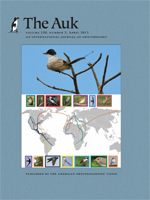 Geolocators are a relatively new tool that allows researchers to track the movements of small animals, such as birds.
Geolocators are a relatively new tool that allows researchers to track the movements of small animals, such as birds.
Instead of sending and receiving a radio signal, geolocators record the angle of sunlight at given hours of the day. You must collect the geolocator unit to retrieve the data. Without the send and receive functions, the unit can be much smaller than other tracking devices. Geolocators have been used even on small songbirds. An algorithm lets you translate the sun angle at a given time into a latitude.
Clearly, it’s a technology with a lot of potential and a lot of limitations. If you are interested in how geolocators can inform your own research, check out the April issue of The Auk, which contains two special sections on geolocator research. The issue’s introductory article is a primer on geolocators, and it’s open access. Read it here.
